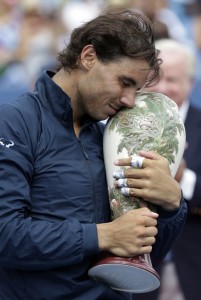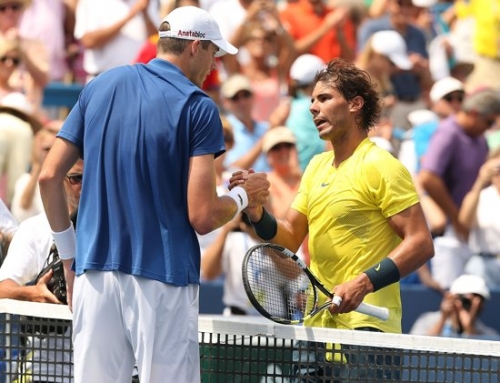 When Djokovic was on his epic win streak in 2011, the tennis media was in a frenzy by the time the French Open rolled around. Djokovic had finally beaten Nadal on clay. He had not lost a match up to that point. Djokovic would eventually lose to Federer in the semis of the French, but come back to win Wimbledon and the US Open. He beat Nadal seven consecutive times that year. What is not mentioned is how great a year Nadal would have had if Djokovic hadn’t upped his level. Many of the finals that Djokovic won came at the expense of Nadal including Wimbledon and the US Open.
When Djokovic was on his epic win streak in 2011, the tennis media was in a frenzy by the time the French Open rolled around. Djokovic had finally beaten Nadal on clay. He had not lost a match up to that point. Djokovic would eventually lose to Federer in the semis of the French, but come back to win Wimbledon and the US Open. He beat Nadal seven consecutive times that year. What is not mentioned is how great a year Nadal would have had if Djokovic hadn’t upped his level. Many of the finals that Djokovic won came at the expense of Nadal including Wimbledon and the US Open.
So it comes with some surprise that Nadal, who is having perhaps his best year on tour (though 2010 was huge too), in terms of wins and losses, is barely registering a whisper. The reasons are several-fold. First, Nadal lost in his first final to Horacio Zeballos in the finals of Chile. Second, and most importantly, he lost in the opening round at Wimbledon. People remember epic losses more than win streaks. Furthermore, when he lost at Wimbledon, there were rumbles that maybe his knee was bothering him once again, and so he might not be able to handle the rigors of the US hardcourt tour.
Nadal was seeking his ninth title of the year. He was seeking his second consecutive Masters 1000 hardcourt title in a row (he had never won two in a row). He was seeking his first Cincy title, having never made the finals. A win would move him to number 2 in the world, and make him the second seed at the US Open.
There was a lot of drama outside of Nadal at Cincy. Marion Bartoli, Wimbledon winner, retired claiming she had been playing in pain, and once she claimed a Slam, her career was done. Maria Sharapova decided to part ways with Jimmy Connors after her opening round loss to Sloane Stephens, after only a single match. Roger Federer decided to go back to his old racquet after a two tournament dalliance with a 98 sq in racquet. Aga Radwanska defaulted her match to attend her grandfather’s funeral. Jo-Wilfried Tsonga said his knees were not in good enough shape to play the US Open and withdrew.
Due to Federer’s lowly rank of 5, he was not guaranteed much protection against any of the top 4 players (which now include Djokovic, Nadal, Murray, and Ferrer). He ended up with the player he probably wanted to face least, Rafa Nadal, in the quarterfinals.
Nadal had already faced Federer twice this year, with both wins to Rafa (QF in Indian Wells and finals of Rome). Roger had not been having a great year in 2013. Until Halle, he had yet to reach a final. He lost in the second round of Wimbledon, his earliest loss in about a decade. He then added Hamburg and Gstaad to his schedule, losing in the semis of Hamburg to Delbonis, a relatively unknown Argentine, and losing in the opening round to Daniel Brands in Gstaad. In those two clay events, Federer was playing with a Wilson prototype, a 98 sq in racquet, rather than his reliable 90 sq in racquet, and seemed ill-at-ease, unable to control the increase in power.
Federer also chose to skip Montreal last week leading to speculation that he wasn’t feeling ready for the hardcourt season.
Federer had two tough matches to meet Nadal. He needed a 9-7 second set tiebreak to beat Kohlschreiber in the opening round, then Tommy Haas had Fed down 6-1, 3-1 before clawing his way back to the win. Given these struggles, and two lopsided losses to Nadal in 2013, many felt Fed’s chances were slim to beat Nadal, and many felt it would not be that close a match.
Nadal didn’t exactly waltz into that match. He had to play Grigor Dimitrov in the previous round. Due to some shaky play on Nadal’s part, Dimitrov was able to claim the second set, 7-5. Although Dimitrov is often called “Baby Fed”, he still has stretches of poorly played points that lead him to trouble, and lost the third set, 6-2.
Then came the match that everyone was hoping for. It wasn’t the 2008 Wimbledon final, when both men ruled the tennis world, and Djokovic and Murray were the pretenders to the throne. Nadal is having the year of his life, and Federer is looking every bit the 32 years of age he is.
Still, Federer found a little magic. Back in Rome, a match Federer lost easily, Federer chose to be ultra aggressive going for the lines. Of course, he made plenty of errors, but he felt that it was the right strategy. In a way, Federer was a bit fortunate that Nadal, having had numerous issues with his knees, was altering his playing style to play shorter points. Nadal’s error counts have gotten much higher, but he’s not playing 20 shot rallies either.
Federer said that Nadal isn’t really playing any different in terms of aggression: it’s how Nadal always plays Federer. Instead, Nadal is playing everyone else how he plays Federer. He’s being much more aggressive.
It didn’t hurt Federer that his serve was working well for the latter parts of the first set and the early parts of the second, enough to get him out of a few scrapes, and to take the first set, 7-5. But once Nadal was able to get enough Federer returns in play, he was able to turn the tide, and Federer once again wilted. Nadal got an early break in the third set, and Roger continued to struggle in return games. Nadal finally reached a 40-0 triple match point lead, but Federer managed to claw his way back to deuce, and was able to fight off another match point before Rafa finally got an advantage and hit a forehand winner.
Or so it would seem. Replay showed the ball was fractionally out. However, it’s always dicey from a “class” view to challenge on match point because it usually halts a celebration by the winner, and Roger didn’t want to be “that guy”.
With the loss, Federer drops to 7 in the world, his lowest ranking since 2002.
Nadal would play Tomas Berdych in the semis. This was a close, 7-5, 7-6 match, one where Berdych was struggling to keep certain shots on the court, but doing well enough to mostly hold serve. Still, Rafa was good enough for the win.
And finally, Isner, who had beaten Gasquet, Raonic, Djokovic and del Potro to reach the finals, all top ten players (roughly speaking–Raonic became 10 at the start of the tournament while Gasquet was 10 last week), went to two tiebreak sets with Nadal, not facing any break points on his own serve, but not able to get minibreaks in the tiebreak when it mattered most.
With the win, Nadal has the lead in the US Open series race, though Isner could still claim it with a semifinal appearance in Winston-Salem next week.



![[Paris] Djokovic finishes post US Open tournaments undefeated with win over Ferrer](https://www.essentialtennis.com/wp-content/uploads/2013/11/20131103nole-500x383.jpg)
![[Shanghai] Djokovic wins the China double, adding Shanghai title to Beijing](https://www.essentialtennis.com/wp-content/uploads/2013/10/20131013nole-500x383.jpg)
![[Shanghai, SF] del Potro upsets Nadal in awesome display of power](https://www.essentialtennis.com/wp-content/uploads/2013/10/20131012delpo-500x383.jpg)

![[Montreal] Nadal crushes Raonic to win 25th Masters 1000 title](https://www.essentialtennis.com/wp-content/uploads/2013/08/20130811nadal-500x383.jpg)